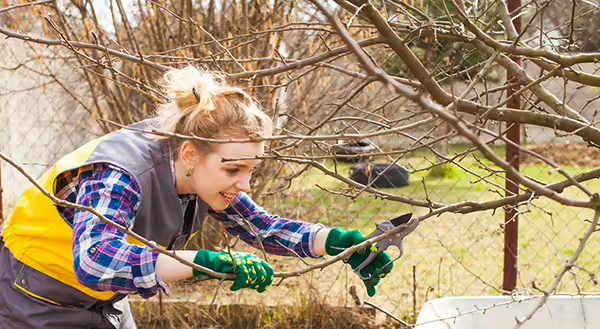
Late winter and early spring are critical transition periods for trees, making the shift from dormancy to active growth. Proper care during these seasons sets the foundation for healthy, vibrant trees throughout the year. Late-winter care along with spring practices, will help trees transition and gives them a good start to the growing season.
Essential late winter and spring tree care practices start with taking a close look at trees and include proper pruning, soil preparation and mulching, watering when needed, and protecting trees from wildlife damage.
Inspect trees for damage
Before spring fully takes hold, insepect your trees to assess their health and identify potential issues. Spotting dead, damaged, or diseased branches is easier in late winter when the lack of foliage provides a clearer view of the tree structure. Look for signs of pest activity or infestations and check for cracks or wounds on the trunk and major branches. Finding these issues in late winter allows time for intervention and prepares trees for the upcoming growing season.
Prune branches
Late winter and early spring is an ideal time for pruning trees as they are dormant and less susceptible to stress.
- Remove dead, damaged, and weak branches to prevent disease and pest infestation.
- Thin dense areas to improve sunlight penetration and air circulation.
- Prune branches to maintain a balanced canopy and reduce the risk of storm damage.
- Use sharp, clean tools and make precise cuts to facilitate rapid sealing.
Dormant Season Pruning Factsheet
Prepare the soil and add mulch
Prepare the soil around your trees for the upcoming growing season by doing a soil test to determine pH levels and nutrient deficiencies. Only amend the soil if needed. To improve soil structure and fertility, incorporate organic matter, such as compost.
Spring is a great time to refresh mulch or add new mulch. Mulch can improve soil health promoting strong root development and overall tree vigor. It also helps the soil retain moisture, suppresses weeds, and regulates the soil temperatures.
Mulch should be 2-4 inches deep and extend out to the drip line, the edge of the tree canopy, if possible. The mulch should not touch the trunk to prevent moisture-related diseases. Refresh the appearance of existing mulchy with a rake, breaking up any mats.
Monitor moisture levels
Late winter and early spring often bring fluctuating weather patterns, including thawing snow, rain, and occasional dry spells. Monitor soil moisture levels around your trees and ensure consistent moisture, especially for newly planted or shallow-rooted trees. Trees need at least 1 inch of water per week. Deep, infrequent watering encourages deep root growth and helps trees withstand drought conditions later in the season.
Protect trees from wildlife
Late winter and early spring can be challenging times for trees as hungry wildlife may browse on tender bark or buds. Install tree guards or fencing to deter deer, rabbits, or rodents from damaging trees. Consider using netting for additional protection, especially for young or vulnerable trees. Protecting trees can prevent significant damage and support healthy tree growth. Avoid using plastic netting as it can harm and kill wildlife.
Late winter and early spring tree care are integral to maintaining a vibrant, healthy landscape. By combining these practices, you can optimize tree health, growth, and longevity. Connect with your local county Extension office or contact an arborist for professional tree care advice when necessary.
About the Author
Jenny Lee coordinates the Master Gardener and Master Naturalist programs in east central Illinois in Coles, Cumberland, Douglas, Moultrie, and Shelby counties. She has a B.S. in Biology and is completing a M.S. in Natural Resources and Environmental Biology. She is a former conservation police officer and enjoys teaching others about the environment.
About the Blog
Naturalist News is a blog by University of Illinois Extension Master Naturalist staff and volunteers who bring you stories highlighting the individuals, places, wildlife and plants that make this state amazing. Join us each week to learn something new, be inspired and become connected to your own community by recognizing the amazing ways we are all intertwined.